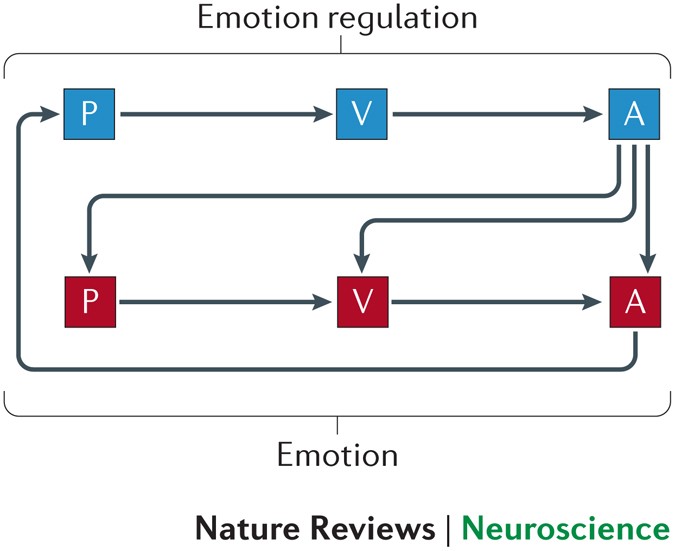
- Select a language for the TTS:
- UK English Female
- UK English Male
- US English Female
- US English Male
- Australian Female
- Australian Male
- Language selected: (auto detect) - EN
Play all audios:
ABSTRACT Emotions are powerful determinants of behaviour, thought and experience, and they may be regulated in various ways. Neuroimaging studies have implicated several brain regions in
emotion regulation, including the ventral anterior cingulate and ventromedial prefrontal cortices, as well as the lateral prefrontal and parietal cortices. Drawing on computational
approaches to value-based decision-making and reinforcement learning, we propose a unifying conceptual framework for understanding the neural bases of diverse forms of emotion regulation.
Access through your institution Buy or subscribe This is a preview of subscription content, access via your institution ACCESS OPTIONS Access through your institution Subscribe to this
journal Receive 12 print issues and online access $189.00 per year only $15.75 per issue Learn more Buy this article * Purchase on SpringerLink * Instant access to full article PDF Buy now
Prices may be subject to local taxes which are calculated during checkout ADDITIONAL ACCESS OPTIONS: * Log in * Learn about institutional subscriptions * Read our FAQs * Contact customer
support SIMILAR CONTENT BEING VIEWED BY OTHERS EMOTION PREDICTION ERRORS GUIDE SOCIALLY ADAPTIVE BEHAVIOUR Article 19 October 2021 A LEVELS-OF-ANALYSIS FRAMEWORK FOR STUDYING SOCIAL EMOTIONS
Article 21 February 2024 NEURAL SIGNATURES OF EMOTION REGULATION Article Open access 20 January 2024 REFERENCES * Gross, J. J. _Handbook of Emotion Regulation_ 2nd edn (Guilford, 2014).
Google Scholar * Aldao, A., Nolen-Hoeksema, S. & Schweizer, S. Emotion-regulation strategies across psychopathology: a meta-analytic review. _Clin. Psychol. Rev._ 30, 217–237 (2010).
Article PubMed Google Scholar * Mauss, I. B., Levenson, R. W., McCarter, L., Wilhelm, F. H. & Gross, J. J. The tie that binds? Coherence among emotion experience, behavior, and
physiology. _Emotion_ 5, 175–190 (2005). Article PubMed Google Scholar * Lang, P. J., Greenwald, M. K., Bradley, M. M. & Hamm, A. O. Looking at pictures: affective, facial, visceral,
and behavioral reactions. _Psychophysiology_ 30, 261–273 (1993). Article CAS PubMed Google Scholar * Bradley, M. M., Codispoti, M., Cuthbert, B. N. & Lang, P. J. Emotion and
motivation I: defensive and appetitive reactions in picture processing. _Emotion_ 1, 276–298 (2001). Article CAS PubMed Google Scholar * Rangel, A., Camerer, C. & Montague, P. R. A
framework for studying the neurobiology of value-based decision making. _Nat. Rev. Neurosci._ 9, 545–556 (2008). Article CAS PubMed PubMed Central Google Scholar * Gross, J. J. Emotion
regulation: current status and future prospects. _Psychol. Inquiry_ 26, 1–26 (2015). Article Google Scholar * Ochsner, K. N. in _Handbook of Emotion Regulation_ 2nd edn (ed. Gross, J. J.)
23–42 (Guilford Press, 2014). Google Scholar * Sabatinelli, D. et al. Emotional perception: meta-analyses of face and natural scene processing. _NeuroImage_ 54, 2524–2533 (2011). Article
PubMed Google Scholar * Mechias, M. L., Etkin, A. & Kalisch, R. A meta-analysis of instructed fear studies: implications for conscious appraisal of threat. _NeuroImage_ 49, 1760–1768
(2010). Article PubMed Google Scholar * Costafreda, S. G., Brammer, M. J., David, A. S. & Fu, C. H. Predictors of amygdala activation during the processing of emotional stimuli: a
meta-analysis of 385 PET and fMRI studies. _Brain Res. Rev._ 58, 57–70 (2008). Article PubMed Google Scholar * Murphy, F. C., Nimmo-Smith, I. & Lawrence, A. D. Functional neuroanatomy
of emotions: a meta-analysis. _Cogn. Affect. Behav. Neurosci._ 3, 207–233 (2003). Article PubMed Google Scholar * Wager, T. D. et al. in _Handbook of Emotions_ 3rd edn (eds Lewis, M. et
al.) 249–271 (Guilford Press, 2008). Google Scholar * McHugh, S. B. et al. Aversive prediction error signals in the amygdala. _J. Neurosci._ 34, 9024–9033 (2014). Article PubMed PubMed
Central CAS Google Scholar * Li, S. S. & McNally, G. P. The conditions that promote fear learning: prediction error and Pavlovian fear conditioning. _Neurobiol. Learn. Mem._ 108,
14–21 (2014). Article PubMed Google Scholar * McNally, G. P., Johansen, J. P. & Blair, H. T. Placing prediction into the fear circuit. _Trends Neurosci._ 34, 283–292 (2011). Article
CAS PubMed PubMed Central Google Scholar * Furlong, T. M., Cole, S., Hamlin, A. S. & McNally, G. P. The role of prefrontal cortex in predictive fear learning. _Behav. Neurosci._ 124,
574–586 (2010). Article PubMed Google Scholar * Spoormaker, V. I. et al. The neural correlates of negative prediction error signaling in human fear conditioning. _NeuroImage_ 54,
2250–2256 (2011). Article CAS PubMed Google Scholar * Cauda, F. et al. Meta-analytic clustering of the insular cortex: characterizing the meta-analytic connectivity of the insula when
involved in active tasks. _NeuroImage_ 62, 343–355 (2012). Article PubMed Google Scholar * Menon, V. Large-scale brain networks and psychopathology: a unifying triple network model.
_Trends Cogn. Sci._ 15, 483–506 (2011). Article PubMed Google Scholar * Beissner, F., Meissner, K., Bar, K. J. & Napadow, V. The autonomic brain: an activation likelihood estimation
meta-analysis for central processing of autonomic function. _J. Neurosci._ 33, 10503–10511 (2013). Article CAS PubMed PubMed Central Google Scholar * Gyurak, A., Gross, J. J. &
Etkin, A. Explicit and implicit emotion regulation: a dual-process framework. _Cogn. Emotion_ 25, 400–412 (2011). Article Google Scholar * Buhle, J. T. et al. Cognitive reappraisal of
emotion: a meta-analysis of human neuroimaging studies. _Cereb. Cortex_ 24, 2981–2990 (2013). Article PubMed PubMed Central Google Scholar * Kohn, N. et al. Neural network of cognitive
emotion regulation — an ALE meta-analysis and MACM analysis. _NeuroImage_ 87, 345–355 (2014). Article CAS PubMed Google Scholar * Sotres-Bayon, F. & Quirk, G. J. Prefrontal control
of fear: more than just extinction. _Curr. Opin. Neurobiol._ 20, 231–235 (2010). Article CAS PubMed PubMed Central Google Scholar * Quirk, G. J., Garcia, R. & González-Lima, F.
Prefrontal mechanisms in extinction of conditioned fear. _Biol. Psychiatry_ 60, 337–343 (2006). Article PubMed Google Scholar * Maren, S. & Quirk, G. J. Neuronal signalling of fear
memory. _Nat. Rev. Neurosci._ 5, 844–852 (2004). Article CAS PubMed Google Scholar * Schiller, D., Levy, I., Niv, Y., LeDoux, J. E. & Phelps, E. A. From fear to safety and back:
reversal of fear in the human brain. _J. Neurosci._ 28, 11517–11525 (2008). Article CAS PubMed PubMed Central Google Scholar * Lissek, S. et al. Neural substrates of classically
conditioned fear-generalization in humans: a parametric fMRI study. _Soc. Cogn. Affect. Neurosci._ 9, 1134–1142 (2013). Article PubMed PubMed Central Google Scholar * Greenberg, T.,
Carlson, J. M., Cha, J., Hajcak, G. & Mujica-Parodi, L. R. Ventromedial prefrontal cortex reactivity is altered in generalized anxiety disorder during fear generalization. _Depress.
Anxiety_ 30, 242–250 (2013). Article PubMed Google Scholar * Nili, U., Goldberg, H., Weizman, A. & Dudai, Y. Fear thou not: activity of frontal and temporal circuits in moments of
real-life courage. _Neuron_ 66, 949–962 (2010). Article CAS PubMed Google Scholar * Mobbs, D. et al. When fear is near: threat imminence elicits prefrontal–periaqueductal gray shifts in
humans. _Science_ 317, 1079–1083 (2007). Article CAS PubMed PubMed Central Google Scholar * Egner, T., Etkin, A., Gale, S. & Hirsch, J. Dissociable neural systems resolve conflict
from emotional versus nonemotional distracters. _Cereb. Cortex_ 18, 1475–1484 (2008). Article PubMed Google Scholar * Etkin, A., Egner, T., Peraza, D. M., Kandel, E. R. & Hirsch, J.
Resolving emotional conflict: a role for the rostral anterior cingulate cortex in modulating activity in the amygdala. _Neuron_ 51, 871–882 (2006). Article CAS PubMed Google Scholar *
Etkin, A., Prater, K. E., Hoeft, F., Menon, V. & Schatzberg, A. F. Failure of anterior cingulate activation and connectivity with the amygdala during implicit regulation of emotional
processing in generalized anxiety disorder. _Am. J. Psychiatry_ 167, 545–554 (2010). Article PubMed PubMed Central Google Scholar * Kerns, J. G. et al. Anterior cingulate conflict
monitoring and adjustments in control. _Science_ 303, 1023–1026 (2004). Article CAS PubMed Google Scholar * Daw, N. D., Niv, Y. & Dayan, P. Uncertainty-based competition between
prefrontal and dorsolateral striatal systems for behavioral control. _Nat. Neurosci._ 8, 1704–1711 (2005). Article CAS PubMed Google Scholar * Dayan, P. & Niv, Y. Reinforcement
learning: the good, the bad and the ugly. _Curr. Opin. Neurobiol._ 18, 185–196 (2008). Article CAS PubMed Google Scholar * Rushworth, M. F. & Behrens, T. E. Choice, uncertainty and
value in prefrontal and cingulate cortex. _Nat. Neurosci._ 11, 389–397 (2008). Article CAS PubMed Google Scholar * Rushworth, M. F., Noonan, M. P., Boorman, E. D., Walton, M. E. &
Behrens, T. E. Frontal cortex and reward-guided learning and decision-making. _Neuron_ 70, 1054–1069 (2011). Article CAS PubMed Google Scholar * Doya, K. Modulators of decision making.
_Nat. Neurosci._ 11, 410–416 (2008). Article CAS PubMed Google Scholar * Bartra, O., McGuire, J. T. & Kable, J. W. The valuation system: a coordinate-based meta-analysis of BOLD fMRI
experiments examining neural correlates of subjective value. _NeuroImage_ 76, 412–427 (2013). Article PubMed Google Scholar * Clithero, J. A. & Rangel, A. Informatic parcellation of
the network involved in the computation of subjective value. _Soc. Cogn. Affect. Neurosci._ 9, 1289–1302 (2013). Article PubMed PubMed Central Google Scholar * Chase, H. W., Kumar, P.,
Eickhoff, S. B. & Dombrovski, A. Y. Reinforcement learning models and their neural correlates: an activation likelihood estimation meta-analysis. _Cogn. Affect. Behav. Neurosci._ 15,
435–459 (2015). Article PubMed PubMed Central Google Scholar * Lee, S. W., Shimojo, S. & O'Doherty, J. P. Neural computations underlying arbitration between model-based and
model-free learning. _Neuron_ 81, 687–699 (2014). Article CAS PubMed PubMed Central Google Scholar * Smittenaar, P., FitzGerald, T. H., Romei, V., Wright, N. D. & Dolan, R. J.
Disruption of dorsolateral prefrontal cortex decreases model-based in favor of model-free control in humans. _Neuron_ 80, 914–919 (2013). Article CAS PubMed PubMed Central Google Scholar
* Otto, A. R., Gershman, S. J., Markman, A. B. & Daw, N. D. The curse of planning: dissecting multiple reinforcement-learning systems by taxing the central executive. _Psychol. Sci._
24, 751–761 (2013). Article PubMed Google Scholar * Otto, A. R., Raio, C. M., Chiang, A., Phelps, E. A. & Daw, N. D. Working-memory capacity protects model-based learning from stress.
_Proc. Natl Acad. Sci. USA_ 110, 20941–20946 (2013). Article CAS PubMed PubMed Central Google Scholar * Dixon, M. L. & Christoff, K. The lateral prefrontal cortex and complex
value-based learning and decision making. _Neurosci. Biobehav. Rev._ 45, 9–18 (2014). Article PubMed Google Scholar * Hutcherson, C. A., Plassmann, H., Gross, J. J. & Rangel, A.
Cognitive regulation during decision making shifts behavioral control between ventromedial and dorsolateral prefrontal value systems. _J. Neurosci._ 32, 13543–13554 (2012). Article CAS
PubMed PubMed Central Google Scholar * Etkin, A., Egner, T. & Kalisch, R. Emotional processing in anterior cingulate and medial prefrontal cortex. _Trends Cogn. Sci._ 15, 85–93
(2011). Article PubMed Google Scholar * Etkin, A. & Wager, T. D. Functional neuroimaging of anxiety: a meta-analysis of emotional processing in PTSD, social anxiety disorder, and
specific phobia. _Am. J. Psychiatry_ 164, 1476–1488 (2007). Article PubMed PubMed Central Google Scholar * Stroop, J. R. Studies of interference in serial verbal reactions. _J. Exp.
Psychol._ 18, 643–662 (1935). Article Google Scholar * Maier, M. E. & di Pellegrino, G. Impaired conflict adaptation in an emotional task context following rostral anterior cingulate
cortex lesions in humans. _J. Cogn. Neurosci._ 24, 2070–2079 (2012). Article PubMed Google Scholar * McRae, K., Ciesielski, B. & Gross, J. J. Unpacking cognitive reappraisal: goals,
tactics, and outcomes. _Emotion_ 12, 250–255 (2012). Article PubMed Google Scholar * McRae, K. et al. The neural bases of distraction and reappraisal. _J. Cogn. Neurosci._ 22, 248–262
(2010). Article PubMed PubMed Central Google Scholar * Wager, T. D., Davidson, M. L., Hughes, B. L., Lindquist, M. A. & Ochsner, K. N. Prefrontal–subcortical pathways mediating
successful emotion regulation. _Neuron_ 59, 1037–1050 (2008). Article CAS PubMed PubMed Central Google Scholar * Lee, H., Heller, A. S., van Reekum, C. M., Nelson, B. & Davidson, R.
J. Amygdala-prefrontal coupling underlies individual differences in emotion regulation. _NeuroImage_ 62, 1575–1581 (2012). Article PubMed Google Scholar * Lapate, R. C. et al. Amygdalar
function reflects common individual differences in emotion and pain regulation success. _J. Cogn. Neurosci._ 24, 148–158 (2012). Article PubMed Google Scholar * Woo, C. W., Roy, M.,
Buhle, J. T. & Wager, T. D. Distinct brain systems mediate the effects of nociceptive input and self-regulation on pain. _PLoS Biol._ 13, e1002036 (2015). Article PubMed PubMed Central
CAS Google Scholar * Dosenbach, N. U. et al. Distinct brain networks for adaptive and stable task control in humans. _Proc. Natl Acad. Sci. USA_ 104, 11073–11078 (2007). Article CAS
PubMed PubMed Central Google Scholar * Dosenbach, N. U. et al. A core system for the implementation of task sets. _Neuron_ 50, 799–812 (2006). Article CAS PubMed PubMed Central Google
Scholar * Niendam, T. A. et al. Meta-analytic evidence for a superordinate cognitive control network subserving diverse executive functions. _Cogn. Affect. Behav. Neurosci._ 12, 241–268
(2012). Article PubMed PubMed Central Google Scholar * Schmeichel, B. J., Volokhov, R. N. & Demaree, H. A. Working memory capacity and the self-regulation of emotional expression and
experience. _J. Pers. Soc. Psychol._ 95, 1526–1540 (2008). Article PubMed Google Scholar * Feeser, M., Prehn, K., Kazzer, P., Mungee, A. & Bajbouj, M. Transcranial direct current
stimulation enhances cognitive control during emotion regulation. _Brain Stimul._ 7, 105–112 (2014). Article PubMed Google Scholar * Raio, C. M., Orederu, T. A., Palazzolo, L., Shurick,
A. A. & Phelps, E. A. Cognitive emotion regulation fails the stress test. _Proc. Natl Acad. Sci. USA_ 110, 15139–15144 (2013). Article CAS PubMed PubMed Central Google Scholar *
Lupien, S. J., Gillin, C. J. & Hauger, R. L. Working memory is more sensitive than declarative memory to the acute effects of corticosteroids: a dose-response study in humans. _Behav.
Neurosci._ 113, 420–430 (1999). Article CAS PubMed Google Scholar * Schoofs, D., Wolf, O. T. & Smeets, T. Cold pressor stress impairs performance on working memory tasks requiring
executive functions in healthy young men. _Behav. Neurosci._ 123, 1066–1075 (2009). Article PubMed Google Scholar * Qin, S., Hermans, E. J., van Marle, H. J., Luo, J. & Fernández, G.
Acute psychological stress reduces working memory-related activity in the dorsolateral prefrontal cortex. _Biol. Psychiatry_ 66, 25–32 (2009). Article PubMed Google Scholar * Goldin, P.
R., McRae, K., Ramel, W. & Gross, J. J. The neural bases of emotion regulation: reappraisal and suppression of negative emotion. _Biol. Psychiatry_ 63, 577–586 (2008). Article PubMed
Google Scholar * Vanderhasselt, M. A., Kuhn, S. & De Raedt, R. 'Put on your poker face': neural systems supporting the anticipation for expressive suppression and cognitive
reappraisal. _Soc. Cogn. Affect. Neurosci._ 8, 903–910 (2013). Article PubMed Google Scholar * Wager, T. D. et al. An fMRI-based neurologic signature of physical pain. _N. Engl. J. Med._
368, 1388–1397 (2013). Article CAS PubMed PubMed Central Google Scholar * Kriegeskorte, N., Mur, M. & Bandettini, P. Representational similarity analysis — connecting the branches
of systems neuroscience. _Front. Syst. Neurosci._ 2, 4 (2008). Article PubMed PubMed Central Google Scholar * Winecoff, A. et al. Ventromedial prefrontal cortex encodes emotional value.
_J. Neurosci._ 33, 11032–11039 (2013). Article CAS PubMed PubMed Central Google Scholar * Delgado, M. R., Nearing, K. I., Ledoux, J. E. & Phelps, E. A. Neural circuitry underlying
the regulation of conditioned fear and its relation to extinction. _Neuron_ 59, 829–838 (2008). Article CAS PubMed PubMed Central Google Scholar * Rescorla, R. A. & Wagner, A. R. in
_Classical Conditioning II: Current Theory and Research_ (eds Black, A. H. & Prokasy, W. F.) 64–99 (Appleton-Century Crofts, 1972). Google Scholar * Pearce, J. M. & Hall, G. A
model for Pavlovian learning: variations in the effectiveness of conditioned but not of unconditioned stimuli. _Psychol. Rev._ 87, 532–552 (1980). Article CAS PubMed Google Scholar *
Boll, S., Gamer, M., Gluth, S., Finsterbusch, J. & Buchel, C. Separate amygdala subregions signal surprise and predictiveness during associative fear learning in humans. _Eur. J.
Neurosci._ 37, 758–767 (2013). Article PubMed Google Scholar * Li, J., Schiller, D., Schoenbaum, G., Phelps, E. A. & Daw, N. D. Differential roles of human striatum and amygdala in
associative learning. _Nat. Neurosci._ 14, 1250–1252 (2011). Article CAS PubMed PubMed Central Google Scholar * Watanabe, N., Sakagami, M. & Haruno, M. Reward prediction error
signal enhanced by striatum–amygdala interaction explains the acceleration of probabilistic reward learning by emotion. _J. Neurosci._ 33, 4487–4493 (2013). Article CAS PubMed PubMed
Central Google Scholar * Staudinger, M. R., Erk, S., Abler, B. & Walter, H. Cognitive reappraisal modulates expected value and prediction error encoding in the ventral striatum.
_NeuroImage_ 47, 713–721 (2009). Article PubMed Google Scholar * Gu, X., Kirk, U., Lohrenz, T. M. & Montague, P. R. Cognitive strategies regulate fictive, but not reward prediction
error signals in a sequential investment task. _Hum. Brain Mapp._ 35, 3738–3749 (2014). Article PubMed Google Scholar * Silvetti, M., Alexander, W., Verguts, T. & Brown, J. W. From
conflict management to reward-based decision making: actors and critics in primate medial frontal cortex. _Neurosci. Biobehav. Rev._ 46, 44–57 (2014). Article PubMed Google Scholar *
Rutledge, R. B., Skandali, N., Dayan, P. & Dolan, R. J. A computational and neural model of momentary subjective well-being. _Proc. Natl Acad. Sci. USA_ 111, 12252–12257 (2014). Article
CAS PubMed PubMed Central Google Scholar * Sheppes, G., Scheibe, S., Suri, G. & Gross, J. J. Emotion-regulation choice. _Psychol. Sci._ 22, 1391–1396 (2011). Article PubMed
Google Scholar * Sheppes, G. et al. Emotion regulation choice: a conceptual framework and supporting evidence. _J. Exp. Psychol. Gen._ 143, 163–181 (2014). Article PubMed Google Scholar
* Milad, M. R. et al. Deficits in conditioned fear extinction in obsessive-compulsive disorder and neurobiological changes in the fear circuit. _JAMA Psychiatry_ 70, 608–618; quiz 554
(2013). Article PubMed Google Scholar * Milad, M. R. et al. Neurobiological basis of failure to recall extinction memory in posttraumatic stress disorder. _Biol. Psychiatry_ 66, 1075–1082
(2009). Article PubMed PubMed Central Google Scholar * Etkin, A. & Schatzberg, A. F. Common abnormalities and disorder-specific compensation during implicit regulation of emotional
processing in generalized anxiety and major depressive disorders. _Am. J. Psychiatry_ 168, 968–978 (2011). Article PubMed Google Scholar * Greening, S. G., Osuch, E. A., Williamson, P. C.
& Mitchell, D. G. The neural correlates of regulating positive and negative emotions in medication-free major depression. _Soc. Cogn. Affect. Neurosci._ 9, 628–637 (2014). Article
PubMed Google Scholar * Kanske, P., Heissler, J., Schonfelder, S. & Wessa, M. Neural correlates of emotion regulation deficits in remitted depression: the influence of regulation
strategy, habitual regulation use, and emotional valence. _NeuroImage_ 61, 686–693 (2012). Article PubMed Google Scholar * Smoski, M. J., Keng, S. L., Schiller, C. E., Minkel, J. &
Dichter, G. S. Neural mechanisms of cognitive reappraisal in remitted major depressive disorder. _J. Affect. Disord._ 151, 171–177 (2013). Article PubMed PubMed Central Google Scholar *
Johnstone, T., van Reekum, C. M., Urry, H. L., Kalin, N. H. & Davidson, R. J. Failure to regulate: counterproductive recruitment of top-down prefrontal-subcortical circuitry in major
depression. _J. Neurosci._ 27, 8877–8884 (2007). Article CAS PubMed PubMed Central Google Scholar * Dillon, D. G. & Pizzagalli, D. A. Evidence of successful modulation of brain
activation and subjective experience during reappraisal of negative emotion in unmedicated depression. _Psychiatry Res._ 212, 99–107 (2013). Article PubMed PubMed Central Google Scholar
* Ball, T. M., Ramsawh, H. J., Campbell-Sills, L., Paulus, M. P. & Stein, M. B. Prefrontal dysfunction during emotion regulation in generalized anxiety and panic disorders. _Psychol.
Med._ 43, 1475–1486 (2013). Article PubMed Google Scholar * Goldin, P. R., Manber, T., Hakimi, S., Canli, T. & Gross, J. J. Neural bases of social anxiety disorder: emotional
reactivity and cognitive regulation during social and physical threat. _Arch. Gen. Psychiatry_ 66, 170–180 (2009). Article PubMed PubMed Central Google Scholar * Goldin, P. R.,
Manber-Ball, T., Werner, K., Heimberg, R. & Gross, J. J. Neural mechanisms of cognitive reappraisal of negative self-beliefs in social anxiety disorder. _Biol. Psychiatry_ 66, 1091–1099
(2009). Article PubMed PubMed Central Google Scholar * New, A. S. et al. A functional magnetic resonance imaging study of deliberate emotion regulation in resilience and posttraumatic
stress disorder. _Biol. Psychiatry_ 66, 656–664 (2009). Article PubMed Google Scholar * Rabinak, C. A. et al. Focal and aberrant prefrontal engagement during emotion regulation in
veterans with posttraumatic stress disorder. _Depress. Anxiety_ 31, 851–861 (2014). Article PubMed PubMed Central Google Scholar Download references ACKNOWLEDGEMENTS A.E. is funded by
the Sierra-Pacific Mental Illness Research, Education and Clinical Center (MIRECC) at the Veterans Affairs Palo Alto Healthcare System. A.E. and J.J.G. are funded by US National Institutes
of Health grants R01MH091860 and R21MH097984. C.B. is funded by European Research Council (ERC) grant ERC-2010-AdG_20100407 and the German Research Foundation (DFG; SFB TRR 58). AUTHOR
INFORMATION AUTHORS AND AFFILIATIONS * Department of Psychiatry and Behavioral Sciences and the Stanford Neurosciences Institute, Stanford University, 401 Quarry Road, Stanford, California
94304, USA; and the Veterans Affairs Palo Alto Healthcare System and the Sierra Pacific Mental Illness, Research, Education and Clinical Center (MIRECC), 3801 Miranda Ave, Palo Alto,
California 94304, USA., Amit Etkin * the Veterans Affairs Palo Alto Healthcare System and the Sierra Pacific Mental Illness, Research, Education and Clinical Center (MIRECC), 3801 Miranda
Ave, Palo Alto, California 94304, USA., Amit Etkin * Department of Systems Neuroscience, University Medical Center Hamburg-Eppendorf, Martinistr 52, Hamburg, 20246, Germany Christian Büchel
* Department of Psychology, Stanford University, 450 Serra Mall, Stanford, 94305, California, USA James J. Gross Authors * Amit Etkin View author publications You can also search for this
author inPubMed Google Scholar * Christian Büchel View author publications You can also search for this author inPubMed Google Scholar * James J. Gross View author publications You can also
search for this author inPubMed Google Scholar CORRESPONDING AUTHOR Correspondence to Amit Etkin. ETHICS DECLARATIONS COMPETING INTERESTS The authors declare no competing financial
interests. POWERPOINT SLIDES POWERPOINT SLIDE FOR FIG. 1 POWERPOINT SLIDE FOR FIG. 2 POWERPOINT SLIDE FOR FIG. 3 POWERPOINT SLIDE FOR FIG. 4 GLOSSARY * Computational modelling The
application of algorithms representing functions computed by the brain to explain observed behaviour through latent variables. * Conditioned stimulus (CS). A previously neutral stimulus that
takes on aversive or rewarding properties after being associated with an unconditioned stimulus. * Limbic regions Deep brain structures (for example, the amygdala, ventral striatum and
brain stem nuclei) involved in emotional and motivational processes. * Prediction errors Discrepancies between experienced stimuli and expectations about them. * Reinforcement learning An
area of study describing changes in behaviour driven by the experience of rewards or punishments. * Transcranial magnetic stimulation (TMS). A method for non-invasive stimulation of the
brain using a focal pulsed magnetic field, which can be used to excite or inhibit brain activity. * Unconditioned stimulus (US). A naturally aversive or rewarding stimulus. * Value A
dimensionless 'universal currency' that denotes the relative 'good for me' or 'bad for me' motivational relevance of a stimulus or action. RIGHTS AND
PERMISSIONS Reprints and permissions ABOUT THIS ARTICLE CITE THIS ARTICLE Etkin, A., Büchel, C. & Gross, J. The neural bases of emotion regulation. _Nat Rev Neurosci_ 16, 693–700 (2015).
https://doi.org/10.1038/nrn4044 Download citation * Published: 20 October 2015 * Issue Date: November 2015 * DOI: https://doi.org/10.1038/nrn4044 SHARE THIS ARTICLE Anyone you share the
following link with will be able to read this content: Get shareable link Sorry, a shareable link is not currently available for this article. Copy to clipboard Provided by the Springer
Nature SharedIt content-sharing initiative





